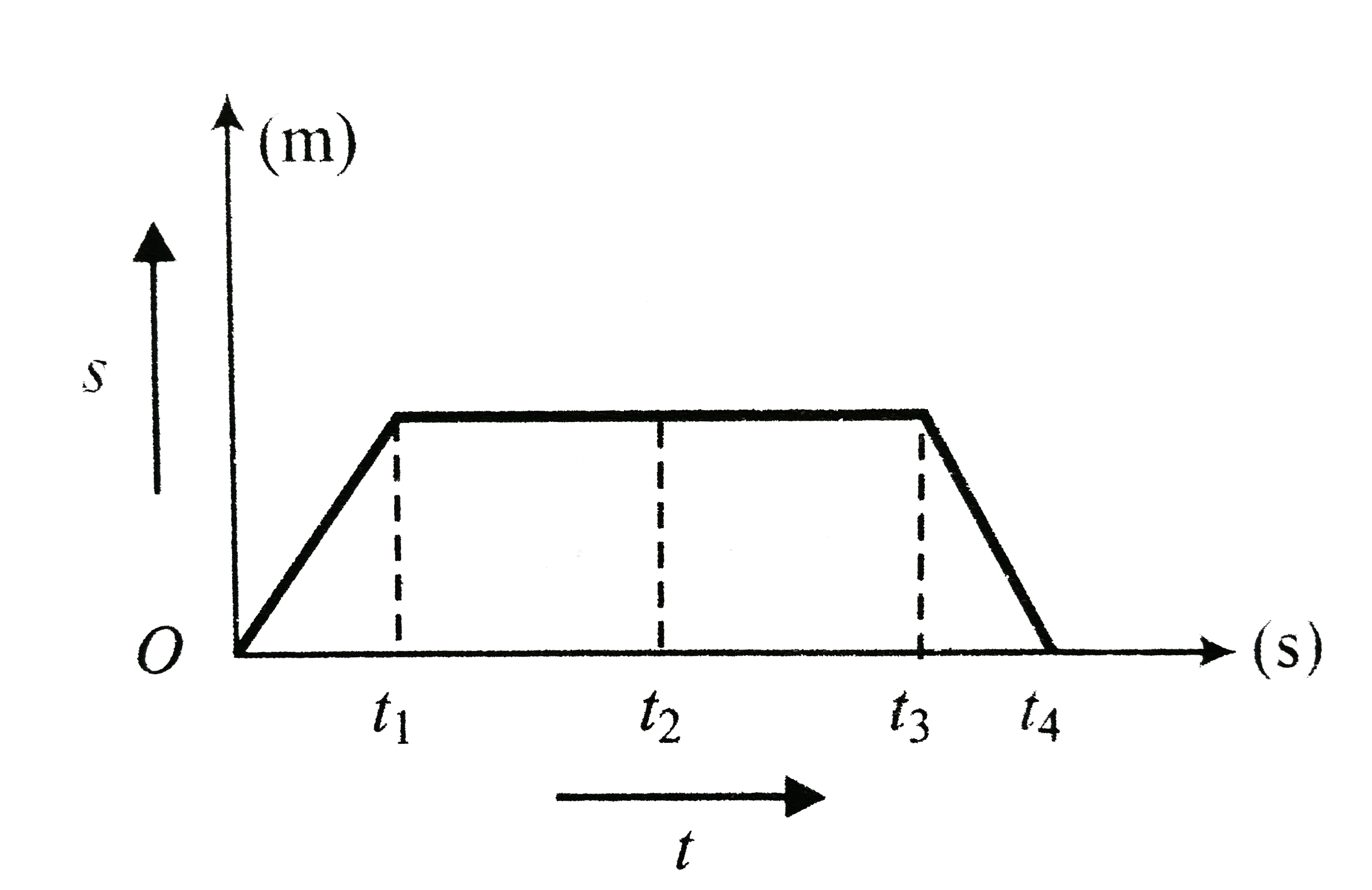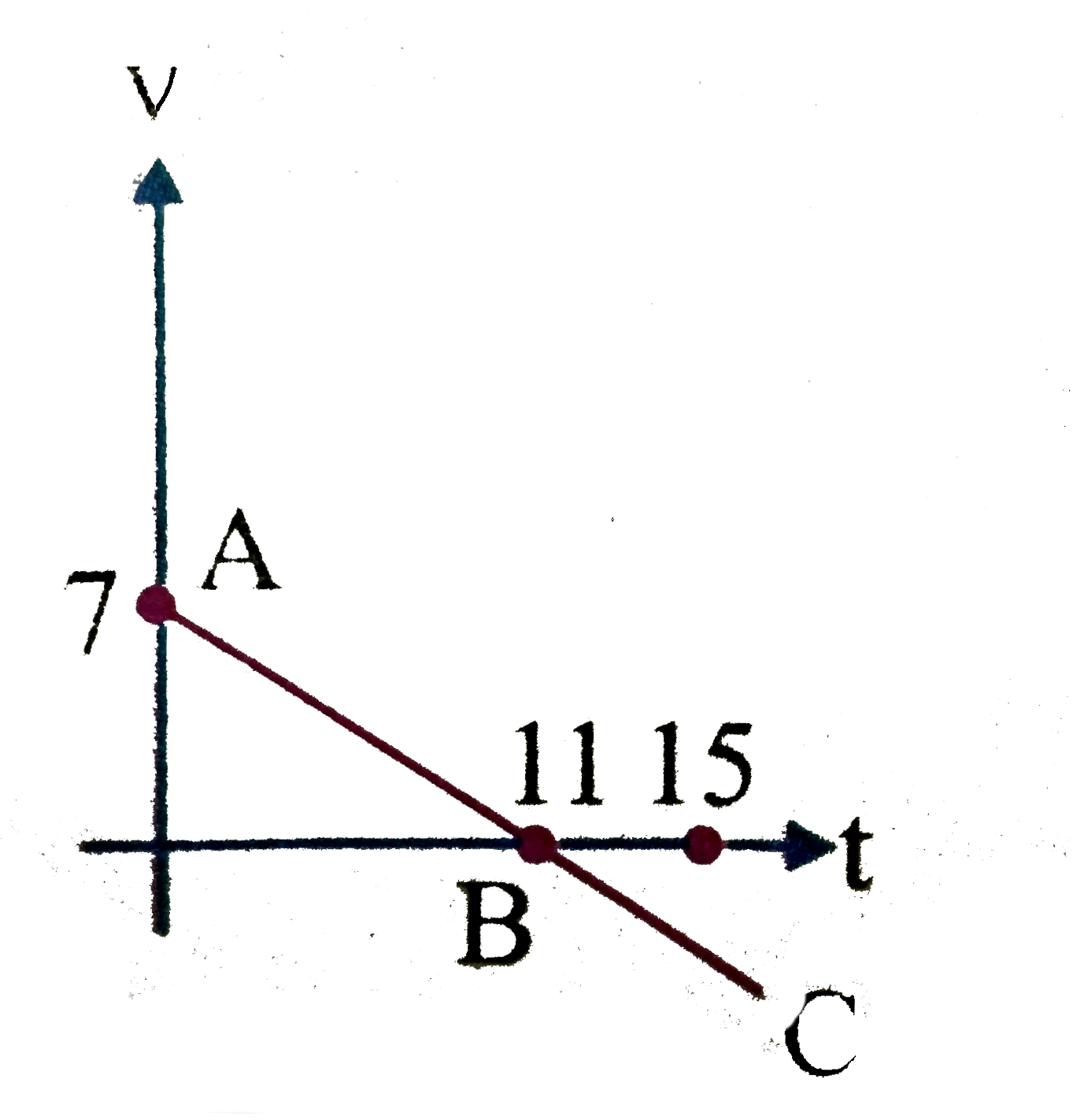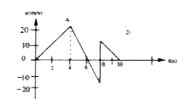Velocity-time graph for the motion of a certain body is shown in Fig. Explain the nature of this motion. Find the initial velocity and acceleration and write the equation for the variation of displacement with time. What happens to the moving body at point B? How does the body move after this moment ? Solution in Telugu
The velocity-time graph is a straight line with-ve slope ,the motion is uniformly retarding one upto point B and uniformly acccelerated after with -ve side of velocity axis.)
The initial velocity at point A is v0=7ms−1
The acceleration a =ΔvΔt=vt−v0Δt=0−7ms−111s=−711ms−2
The equation of motion for this body for variation of displacement with time is
S=7t−120.64t2=7t−0.32t2
If B the body of instantaneous test and then reverse direction.

Topper's Solved these Questions
- BOOK - AAKASH SERIESCHAPTER - MOTION IN A STRAIGHT LINE EXERCISE - Numerical exercise(LEVEL-1)22videos
MOTION IN A STRAIGHT LINE
- BOOK - AAKASH SERIESCHAPTER - MOTION IN A STRAIGHT LINE EXERCISE - Numerical exercise(LEVEL-2)26videos
MOTION IN A STRAIGHT LINE
- BOOK - AAKASH SERIESCHAPTER - MOTION IN A STRAIGHT LINE EXERCISE - PRACTICE EXERCISE58videos
MOTION IN A STRAIGHT LINE
- BOOK - AAKASH SERIESCHAPTER - MOTION IN A PLANEEXERCISE - QUESTION FOR DESCRIPTIVE ANSWER7videos
MOTION IN A PLANE
- BOOK - AAKASH SERIESCHAPTER - MOVING CHARGES AND MAGNETISMEXERCISE - EXERCISE-III45videos
MOVING CHARGES AND MAGNETISM
Similar Questions
A motor vehicle travelled the first third of a distance s at a speed of v1=10 kmph, the second third at a speed of v2=20 kmph and the last third at a speed of v3=60kmph determine the mean speed of the vehicle over the entire distances.
02:33View SolutionA cyclist takes two minutes to compete half revolution on a circular path of 120 m radius.What is his average speed?
01:38View SolutionIf a cyclist takes two minutes to compete half revolution on a circular path of 120 m radius. What is the average speed?
06:08View SolutionA particle is projected over a triangle from one end of a horizontal base and garzing the vertex falls on the other end of the base . If α and β the base angles and θ the angle of projection then show that tanθ=tanα+tanβ.
03:40View SolutionA proton, a deuteron and an a particle having same momentum enter a uniform magnetic field at right angles to the field. Then the ratio of their angular momenta during their motion in the magnetic field is
01:53View SolutionThe displacement-time graph of a body is shown in.
 .
.
The velocity-time graph of the motion of the body will be .04:36View SolutionIf velocity-time graph of a body is as shown in figure, what is the nature of motion ?
04:12View Solution
Velocity-time graph for the motion of a certain body is shown in fig. Explain the nature of this motion. Find the initial velocity and acceleration and write the equation for the variation of displacement with time. What happens to the moving body at point B? how will the body more after this moment?View SolutionWhat is the nature of the displacement-time graph of a body moving with constant velocity ?
04:36View SolutionThe velocity time graph of a body moving along a straight line is shown in Fig. The acceleration of the body during OA will be:
View SolutionVelocity-time graph for the motion of a certain body is shown in Fig. Explain the nature of this motion. Find the initial velocity and acceleration and write the equation for the variation of displacement with time. What happens to the moving body at point B? How does the body move after this moment ?
View SolutionThe velocity-time graph of a body moving in a straight line is shown in Fig. Find the displacement and distance travelled by the body in 10 sec.
 View Solution
View SolutionVelocity-time graph for the motion of a certain body is shown in fig.Explain the nature of this motion.Find the initial velocity and acceleration and write the equation for the variation of disaplacement with time.What happens to the moving body at point B?How does the body move after this movement ?
View SolutionVelocity-time graph for the motion of a certain body is shown in Fig. Explain the nature of this motion. Find the initial velocity and acceleration and write the equation for the variation of displacement with time. What happens to the moving body at point B? How does the body move after this moment ?
06:54View SolutionVelocity-time graph for the motion of a certain body is shown in Fig. Explain the nature of this motion. Find the initial velocity and acceleration and write the equation for the variation of displacement with time. What happens to the moving body at point B? How does the body moves after this moment?
01:06View Solution

